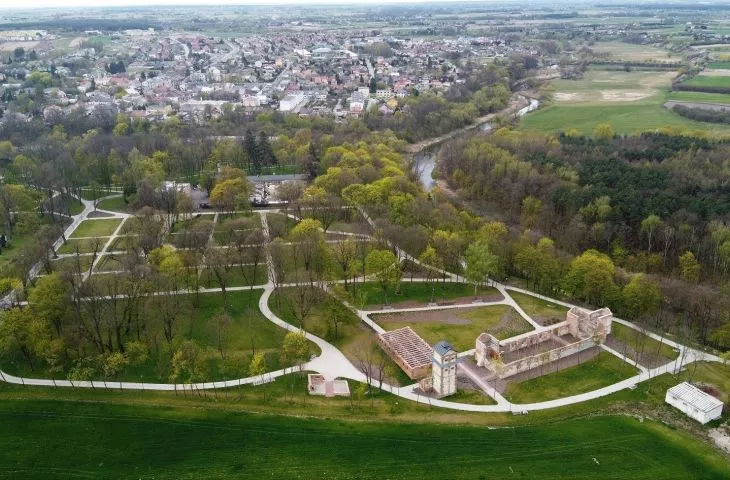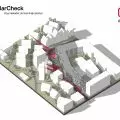The revitalization of Podzamcze Park in Leczna received second prize in the Society of Polish Town Planners' competition for the best developed public space in Poland, 2020 edition, in the category: Revitalized public space in greenery. Read about the history of the manor-park foundation, the various stages of its construction and transformation.
The author's team, consisting of: Piotr Hradecki - Piotr Hardecki Architekt in cooperation with Filip Twardowski and Tomasz Trzupek. Meanwhile, Beata Kanska of Kanska design office and Milena Gawąd of Argo Atelier were responsible for the landscape architecture. The jury appreciated the project for its recreation of a quaternary Italian garden and a 19th-century romantic park. The jury's full statement can be found in the article on the results of the TUP competition.
The remains of the buildings were developed in the form of ruins
photo: Lukasz Trojanowski
once a castle, now a park
Thehistory of the manor-park complex in Leczna has always been connected with the town, theLeczna estate and the numerous owners of the property. In 1467, as a result of the efforts of Jan of Tęczyn, the castellan of Krakow, Leczna was granted city rights. Meanwhile, around 1525, at the confluence of two rivers, a fortified castle was built on a hill, and probably with it a typical Renaissance garden. After the Swedish invasion, the castle was ruined and never rebuilt again. Today there is no trace of the fortress, but its location has been confirmed by archaeological research.
plan of the farmstead in Leczna
© Piotr Hradecki Architect
In 1879 the estate was purchased by Jan Gotlib Bloch - a banker and entrepreneur, philanthropist, creator and builder of railroads in what was then Russia. In 1881 he built a stable, later a granary, and in the following years many brick buildings. He also brought in a Warsaw architect, Adolf Schimmelphennig, who erected a brick villa-palace next to the old manor house. During his time, the park was recomposed into a landscape layout and fenced. At the end of the 19th century and the beginning of the 20th century Leczna was famous for breeding race horses, then stables were built on the estate.
photo of the racing stable in Leczna published in the magazine "Kraj" published in St. Petersburg 11 (24) May 1901,
supplement entitled. "Horse, racing and provincial livestock exhibitions".
Source: facebook, the group Save the Leczna County from oblivion
After World War II, in 1946, the estate was taken over by the State Treasury. For many years, the manor buildings housed the State Agricultural Farm PGR and the Horticultural Combine. In 1981 it was transformed into the State Horticultural Enterprise, which was dissolved in the early 1990s. Meanwhile, the palace and an outbuilding in 1970 were occupied by the TEWA Semiconductor Factory, which was privatized in 1993. The neglected palace fell into disrepair, and as a result of regime changes, the unattended buildings of the former grange, after successive fires, turned into rubble, gradually appropriated by wildly growing greenery. The former stable for racehorses with a saddle house with two flanking towers burned down in 1999. The stable building with carriage house burned down in 2014. A brick tower once used for drying hops and chipped linden rows preserving the geometry of the former plantings remain in relatively good condition.
comprehensive revitalization
In 2007, the site, located in the buffer zone of the Nadwieprzanski Landscape Park, along with the entire urban layout, was entered in the register of monuments. However, the decision to start comprehensive revitalization was made in the fall of 2015. The preparation of revitalization using public consultation involved residents and community organizations. The revitalization activities covered almost twelve hectares of land with the manor house and its surroundings, the central part of the park in front of the palace and the valley of the Wieprz and Swinka rivers.
The ruined interior of the stables in 2015
Photo: Piotr Hradecki Architect
The undertaking was divided into projects: revitalization of the Podzamcze manor-park complex, including restoration of the 18th-century Italian garden along with the historic park layout, protection of cultural heritage resources (protection in the form of picturesque ruins of the remains of the former manor house at Podzamcze and adaptation of the former hops drying room into a viewing tower), restoration of the alley system of the 19th-century romantic park, originally laid out on slopes descending towards the nearby rivers.
italian garden and landscape park
The premise of the first stage of revitalization was to recreate the garden's historical compositional arrangements while adapting them to the modern needs of users. The architects put a lot of effort into finding historical, cartographic and descriptive materials. After studying the existing documents, the author's team decided to recreate a 19th-century landscape park with a touch of an 18th-century Italian garden.
After removing the plaster, traces of architectural decoration were exposed
Photo: Lukasz Trojanowski
The geometric garden was reconstructed to a modest extent - the proportions of the plots and the layout shaped by the historical rows of two-hundred-year-old linden trees were preserved. Decorative plots were created around the central point, highlighted by cut, low hedges, between which were plantings of perennials that bloom from spring to autumn. The rest of the inner space and the plots were accented with turf grass with daisies blooming in season. The choice of species was based by the architects on the compositions of former baroque single-story gardens with artistic and color effects. In the part of the park closest to the center, an outdoor gym was made.
The former hop drying room was adapted into a viewing tower
Photo: Lukasz Trojanowski
revitalization of the remains of the grange
The next step was to preserve as much of the original buildings of the grange as possible. Due to the impossibility of restoring the destroyed buildings, the remains were developed in the form of ruins, secured and available for visiting. After scraping off the plaster, traces of architectural decoration in the form of facing with broken stone (limestone) were exposed, as well as evidence of multiple alterations and rebuildings. A flower meadow was created in the former farm yard, and birch trees were planted inside the walls of the burned stable.
Openwork staircase to the observation tower
Photo: Marcin Czechowicz
Apergola based on the walls left over from the second farm building recalls the layout of the former ceiling beams. The integrity of the ensemble is emphasized with a clinker pavement floor. The former hop drying room, preserved in its best condition, was adapted into a viewing tower. Inside the tower, a cantilevered openwork staircase was installed, ending in a perimeter gallery attached to the existing walls. All contemporary elements were made of hot-dip galvanized steel.
environmental education and tourism
The final, third stage was the creation of a concept for the development of naturally valuable areasfor recreation, tourism and environmental education. The main objective of this project is to raise the ecological awareness of Leczna residents and tourists visiting the city. The historical course of the alleys laid out on the slopes of the escarpments descending towards the Wieprz and Świnka rivers has been restored.
The revitalized park serves as the city's living room
photo: Lukasz Trojanowski
Since its opening, Podzamcze Park has served as an urban living room, a place for strolls and a local attraction. The park hosts events, special runs, sports training, activities for seniors, open-air photography sessions, picnics and meetings. The revitalization was co-financed by the European Union with funds from the European Regional Development Fund under the Regional Operational Program of the Lublin Province for 2014-2020.
the future of Leczna
The attractive development of the park is expected to become a stimulus for further development of tourism in Leczna. The meadow area to the north of the park is a land reserve for future program-enriching investments, such as inns, motels, or guesthouses with cafes or intimate restaurants. In the immediate vicinity of the park by the Wieprz River, two canoe marinas are planned with the aim of restoring canoeing traditions, popularizing the region's natural wealth and increasing the city's tourist potential.









































































